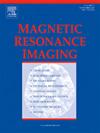全自动测量主动脉脉冲波速度从常规心脏MRI研究。
IF 2
4区 医学
Q2 RADIOLOGY, NUCLEAR MEDICINE & MEDICAL IMAGING
引用次数: 0
摘要
主动脉脉波速度(Aortic pulse wave velocity, PWV)是心血管疾病的预后生物标志物,可通过主动脉路径长度除以脉冲传递时间来测量。然而,目前的MRI技术需要特殊的序列和耗时的人工分析。我们的目标是使用深度学习从标准序列中测量PWV的过程完全自动化,从而促进常规临床和研究扫描中的PWV测量。方法:建立深度学习(DL)模型,从常规的2D跨轴SSFP定位器图像中生成高分辨率的3D主动脉切分,并使用所得切分的中心线来估计主动脉路径长度。进一步建立DL模型,在相位对比图像中自动分割升降主动脉,并根据采样的血流曲线估计脉冲传递时间。与训练有素的观察者进行路径长度、主动脉流分割和传输时间的定量比较,使用外部临床数据集(包括定位器和获得的配对3D图像)或UK Biobank受试者样本。对来自英国生物银行的1053名受试者进行了临床研究扫描的潜在应用评估。结果:主动脉路径长度测量准确,所提出的方法(125 ± 19 mm)与训练有素的观测者手动测量(124 ± 19 mm)之间无显著差异(P = 0.88)。自动化阶段对比图像分割是类似于一个训练有素的观察者的提升(骰子vs手册:0.96)和0.89(骰子)降动脉无主要区别在运输途中时间估计(方法 = 21 ± 9 女士,手动 = 22 ± 9 女士; = 0.15页)。1053例(92 %)UK Biobank受试者中有966例成功分析,中位PWV为6.8 m/s,每10岁增加27 %,收缩压每升高10 mmHg增加6.5 %。结论:我们描述了一种完全自动化的方法,用于测量标准心脏MRI定位器和单相对比成像平面的PWV。该方法具有鲁棒性,可以应用于常规临床扫描,并可以在大规模临床和人群研究中释放测量PWV的潜力。所有的模型和部署代码都可以在线获得。本文章由计算机程序翻译,如有差异,请以英文原文为准。
Fully automated measurement of aortic pulse wave velocity from routine cardiac MRI studies
Introduction
Aortic pulse wave velocity (PWV) is a prognostic biomarker for cardiovascular disease, which can be measured by dividing the aortic path length by the pulse transit time. However, current MRI techniques require special sequences and time-consuming manual analysis. We aimed to fully automate the process using deep learning to measure PWV from standard sequences, facilitating PWV measurement in routine clinical and research scans.
Methods
A deep learning (DL) model was developed to generate high-resolution 3D aortic segmentations from routine 2D trans-axial SSFP localizer images, and the centerlines of the resulting segmentations were used to estimate the aortic path length. A further DL model was built to automatically segment the ascending and descending aorta in phase contrast images, and pulse transit time was estimated from the sampled flow curves. Quantitative comparison with trained observers was performed for path length, aortic flow segmentation and transit time, either using an external clinical dataset with both localizers and paired 3D images acquired or on a sample of UK Biobank subjects. Potential application to clinical research scans was evaluated on 1053 subjects from the UK Biobank.
Results
Aortic path length measurement was accurate with no major difference between the proposed method (125 ± 19 mm) and manual measurement by a trained observer (124 ± 19 mm) (P = 0.88). Automated phase contrast image segmentation was similar to that of a trained observer for both the ascending (Dice vs manual: 0.96) and descending (Dice 0.89) aorta with no major difference in transit time estimation (proposed method = 21 ± 9 ms, manual = 22 ± 9 ms; P = 0.15). 966 of 1053 (92 %) UK Biobank subjects were successfully analyzed, with a median PWV of 6.8 m/s, increasing 27 % per decade of age and 6.5 % higher per 10 mmHg higher systolic blood pressure.
Conclusions
We describe a fully automated method for measuring PWV from standard cardiac MRI localizers and a single phase contrast imaging plane. The method is robust and can be applied to routine clinical scans, and could unlock the potential of measuring PWV in large-scale clinical and population studies. All models and deployment codes are available online.
求助全文
通过发布文献求助,成功后即可免费获取论文全文。
去求助
来源期刊

Magnetic resonance imaging
医学-核医学
CiteScore
4.70
自引率
4.00%
发文量
194
审稿时长
83 days
期刊介绍:
Magnetic Resonance Imaging (MRI) is the first international multidisciplinary journal encompassing physical, life, and clinical science investigations as they relate to the development and use of magnetic resonance imaging. MRI is dedicated to both basic research, technological innovation and applications, providing a single forum for communication among radiologists, physicists, chemists, biochemists, biologists, engineers, internists, pathologists, physiologists, computer scientists, and mathematicians.
 求助内容:
求助内容: 应助结果提醒方式:
应助结果提醒方式:


